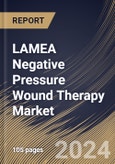NPWT is employed in the fixation of flaps and grafts, promoting their adherence and viability. By applying negative pressure to secure these tissue transfers, NPWT helps reduce the risk of graft failure, ensuring successful integration and wound closure. Orthopedic surgeries, like joint replacements and spinal procedures, often involve extensive incisions and potential complications. NPWT aids in orthopedic wound management by facilitating optimal healing conditions, reducing the risk of infections, and supporting the recovery of patients undergoing these procedures.
NPWT is often used as a bridge to definitive wound closure, allowing healthcare providers to manage complex wounds over an extended period. This approach is especially beneficial in cases where immediate closure is not feasible and staged wound management is required. NPWT is utilized in the management of wounds associated with peripheral arterial disease. NPWT contributes to limb salvage efforts in patients with compromised vascular circulation by promoting tissue perfusion and supporting angiogenesis.
NPWT has been increasingly adopted in hospitals, clinics, and wound care centers across the UAE. The UAE has invested significantly in developing advanced healthcare infrastructure, including adopting cutting-edge medical technologies. Ongoing advancements in NPWT technology, including the development of portable and user-friendly devices, contribute to the accessibility and ease of use of NPWT in healthcare settings in the UAE. Additionally, Venous leg ulcers are a significant health concern globally, and their prevalence tends to increase with factors such as aging populations, sedentary lifestyles, and the presence of venous insufficiency in Saudi Arabia. As these factors become more prevalent in Saudi Arabia, there is a subsequent rise in the incidence of venous leg ulcers. Therefore, due to these aspects, the market will expand across the LAMEA region in the coming years.
The Brazil market dominated the LAMEA Negative Pressure Wound Therapy Market, By Country in 2022, and would continue to be a dominant market till 2030; thereby, achieving a market value of $77 million by 2030. The Argentina market is showcasing a CAGR of 8.7% during (2023 - 2030). Additionally, The UAE market would register a CAGR of 7.8% during (2023 - 2030).
Based on End-Use, the market is segmented into Hospitals, Homecare, and Others. Based on Product, the market is segmented into Conventional NPWT, and Single-use NPWT. Based on Type, the market is segmented into Pressure Ulcers, Diabetic Foot Ulcers, Venous Leg Ulcers, Burn Wounds, and Others. Based on countries, the market is segmented into Brazil, Argentina, UAE, Saudi Arabia, South Africa, Nigeria, and Rest of LAMEA.
List of Key Companies Profiled
- 3M Company
- Talley Group Ltd. (Direct Healthcare Group)
- Smith & Nephew PLC
- Molnlycke Health Care AB
- DeRoyal Industries, Inc.
- ConvaTec Group PLC
- Cardinal Health, Inc.
- HARTMANN Group (Paul Hartmann AG)
- Cork Medical, LLC
Market Report Segmentation
By End-Use- Hospitals
- Homecare
- Others
- Conventional NPWT
- Single-use NPWT
- Pressure Ulcers
- Diabetic Foot Ulcers
- Venous Leg Ulcers
- Burn Wounds
- Others
- Brazil
- Argentina
- UAE
- Saudi Arabia
- South Africa
- Nigeria
- Rest of LAMEA
Table of Contents
Companies Mentioned
- 3M Company
- Talley Group Ltd. (Direct Healthcare Group)
- Smith & Nephew PLC
- Molnlycke Health Care AB
- DeRoyal Industries, Inc.
- ConvaTec Group PLC
- Cardinal Health, Inc.
- HARTMANN Group (Paul Hartmann AG)
- Cork Medical, LLC








